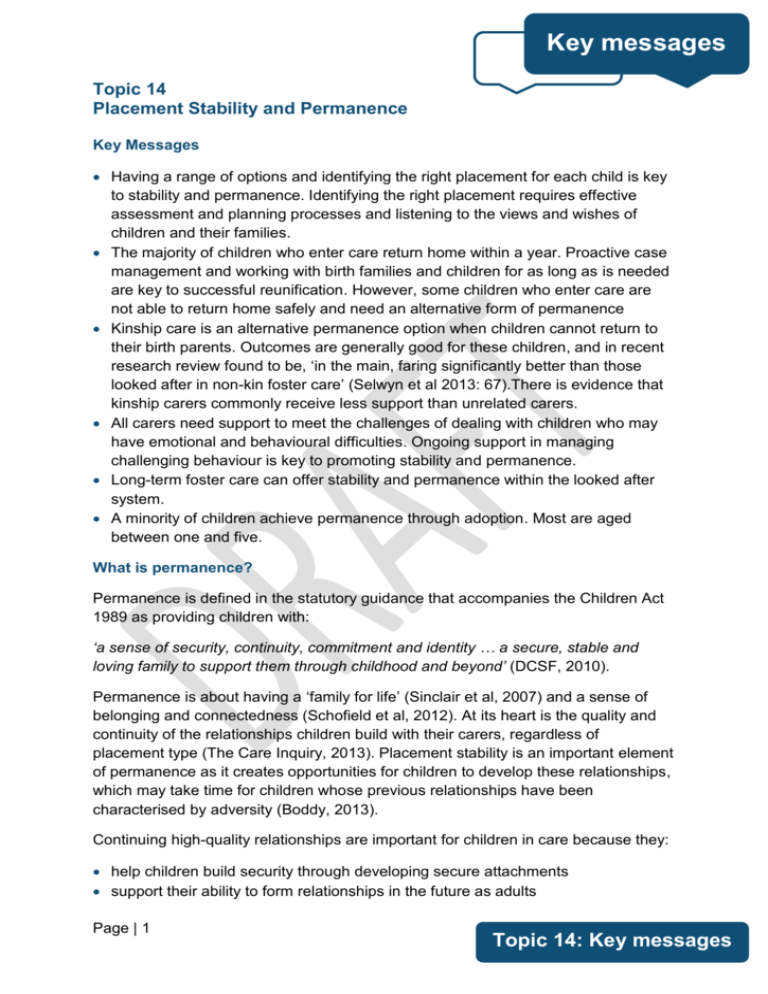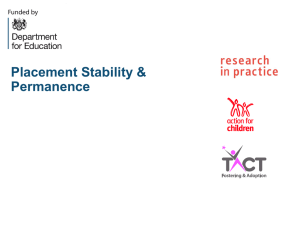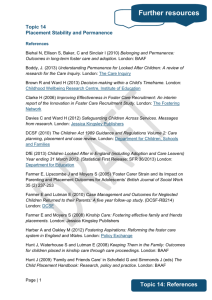14 Placement stability and permanence key messages as a Word
advertisement

Key messages Topic 14 Placement Stability and Permanence Key Messages Having a range of options and identifying the right placement for each child is key to stability and permanence. Identifying the right placement requires effective assessment and planning processes and listening to the views and wishes of children and their families. The majority of children who enter care return home within a year. Proactive case management and working with birth families and children for as long as is needed are key to successful reunification. However, some children who enter care are not able to return home safely and need an alternative form of permanence Kinship care is an alternative permanence option when children cannot return to their birth parents. Outcomes are generally good for these children, and in recent research review found to be, ‘in the main, faring significantly better than those looked after in non-kin foster care’ (Selwyn et al 2013: 67).There is evidence that kinship carers commonly receive less support than unrelated carers. All carers need support to meet the challenges of dealing with children who may have emotional and behavioural difficulties. Ongoing support in managing challenging behaviour is key to promoting stability and permanence. Long-term foster care can offer stability and permanence within the looked after system. A minority of children achieve permanence through adoption. Most are aged between one and five. What is permanence? Permanence is defined in the statutory guidance that accompanies the Children Act 1989 as providing children with: ‘a sense of security, continuity, commitment and identity … a secure, stable and loving family to support them through childhood and beyond’ (DCSF, 2010). Permanence is about having a ‘family for life’ (Sinclair et al, 2007) and a sense of belonging and connectedness (Schofield et al, 2012). At its heart is the quality and continuity of the relationships children build with their carers, regardless of placement type (The Care Inquiry, 2013). Placement stability is an important element of permanence as it creates opportunities for children to develop these relationships, which may take time for children whose previous relationships have been characterised by adversity (Boddy, 2013). Continuing high-quality relationships are important for children in care because they: help children build security through developing secure attachments support their ability to form relationships in the future as adults Page | 1 Topic 14: Key messages Key messages Topic 14 Placement Stability and Permanence help them develop a strong sense of belonging and identity. (The Care Inquiry, 2013) Permanence can be reached through different pathways: a return to birth parents shared care arrangements permanence within the looked after system: a residential placement, long-term unrelated foster care, or family and friends care legal permanence (adoption, special guardianship, residence orders). (Boddy, 2013) The impact of instability Children and young people who are removed from their family suffer separation and feelings of loss, even if they have been maltreated. These feelings are compounded when they experience multiple placements (Schofield and Beek, 2005). Placement instability reduces a child’s opportunities to develop secure attachments. It may also exacerbate any existing behavioural and emotional difficulties (Schofield and Beek, 2005), making it more difficult for children to establish relationships with carers and contributing to further placement breakdown and rejection (Munro and Hardy, 2006). (See also Briefing 2 on ‘Attachment theory and research’.) Eleven per cent of looked after children had three or more placements during the year ending 31 March 2013. Teenagers who were aged between 13 and 16 when they become looked after were those most likely to have three or more placements (Department for Education, 2013). This data is consistent with earlier research which found that adolescents who entered care for the first time after age 11 experienced the least placement stability (Rees et al, 2011). For further data and information on the stability of care placements and how this can be improved see the Department for Education’s Data Pack on Improving Permanence for Looked After Children Children who have many changes of placement fare worse than those who do not in terms of psychological, social and academic outcomes. Placement moves often entail a change of school and can also have an impact on health care because of the time taken to transfer records and set up new appointments (Ward, 2009). It must not be forgotten that moves can be positive, however. Long-term foster care is beneficial only if the child is happy there (Sinclair, 2005). Some children who were Page | 2 Topic 14: Key messages Key messages Topic 14 Placement Stability and Permanence unhappy in their long-term placement have reported that no one listened to them or was prepared to take them out of the placement (Sinclair et al, 2007). This highlights the importance of listening to children regarding their placement and care plan. (See Briefing 9 on ‘Communicating effectively’.) Placement planning and support Identifying the right placement for each child is key to stability and permanence. However, a shortage of suitable placements often leads to decisions to place children in care being put off until there is a crisis. This leads to an ‘emergency’ placement as a stop-gap solution, necessitating a subsequent move (Ward, 2009). However, the move to a more permanent placement is then often delayed once the pressure is off (Brown and Ward, 2013). (See Briefing 11 on ‘Analysing and using information to inform decision making’). One study found that 54 per cent of placement changes are initiated by agencies for reasons related to delayed entry into care or over-optimistic expectations of a swift reunification (Ward, 2009). It is critically important to have a sufficient pool of foster carers and adopters to cater for the varied needs of children. Without it, there is a lack of placement choice and this is associated with placement instability (Clarke, 2006). The commissioning of residential provision, which must include an emphasis on the quality of relationships, is also critical to ensuring a range of placement options is available (Care Inquiry, 2013). When planning the placement, social workers need to conceptualise all options with the objective of providing permanence (Boddy, 2013). Children need to be consulted over their care plan, which needs to be reviewed regularly to take account of changes to their wishes. Involving children in the decision making can improve the quality of decisions and lead to more stable placements (Thomas, 2009). Social workers need to ensure that planning and practice for older children is proactive. Farmer and Lutman (2010) found that planning for this age group is generally less proactive than it is for younger children. They found that the cut-off age beyond which neglected children more often ended up with unstable outcomes and more rarely achieved permanence outside the family was as low as six years. Care can be a positive experience for children who have been chronically maltreated. In terms of stability and well-being, outcomes for chronically maltreated children who remain looked after are generally better than for children who return home (Wade et al, 2010; Davies and Ward, 2012). Support should be part of all care plans to ensure the best outcomes for children and to prevent carer strain and placement breakdown (Boddy, 2013). Page | 3 Topic 14: Key messages Key messages Topic 14 Placement Stability and Permanence Carers also need to be provided with information about the child so they can prepare for the placement. Placements made in a hurry, without consultation and without full information being given to the carer are more likely to disrupt (Sinclair, 2009). Hear Nina Biehal talking about the Characteristics, Outcomes and Meanings of Four Types of Permanent Placement Study as part of the Adoption Research Initiative And to hear more about matching processes, listen to Elaine Farmer in another interview for the Adoption Research Initiative: Linking and Matching in Adoption Reunification with the birth family For most children who become looked after, returning to the birth family will be the preferred pathway to permanence (Boddy, 2013). The majority return home quickly (70% of foster placements that ceased during the year ending 31 March 2013 were for less than a year – DfE, 2013). However, children’s chances of returning to their family decline as time goes by (Boddy, 2013). Many maltreated children who return home after a period in care do not stay. Wade’s study compared maltreated children who went home with those who remained looked after. Only a third of those who went home remained there continuously over the next four years (Wade et al, 2011). Farmer and Lutman (2010) found that 65 per cent of the neglected children in their study who returned home were back in care at five-year follow-up. Younger children and children who return home with another looked after sibling are more likely to return home successfully than older children (Davies and Ward, 2012). Repeated efforts are often made to return maltreated children home when it is not safe to do so (Sinclair et al, 2007). In one study, around half of those who had been abused or neglected suffered further abuse when they returned home (Farmer and Lutman, 2010). There is also evidence that once children return home, cases often close within six months, even where there are continuing concerns (NSPCC, 2012). Proactive case management and working with birth parents is crucial for successful reunification for maltreated children (Farmer and Lutman, 2010). (see Briefing 16 Working with birth parents). The return home must be planned and well managed. Before and after the return there needs to be: Page | 4 Topic 14: Key messages Key messages Topic 14 Placement Stability and Permanence evidence of improvement in parenting capacity, including measurable improvements in the areas of original concern (see Briefing 8 Monitoring and enabling parenting capacity ) an accurate assessment of risk (see Briefing 11 Analysing and using information) provision of services to support children and their families for as long as is needed. (Davies and Ward, 2012) A presentation on Social Work Interventions (including reunification) can be found here: Safeguarding Children Research Initiative Permanence through unrelated foster care Foster care can provide permanence within the care system and is an important permanency option for children who have a strong sense of identity with their birth family. It can provide children with the security and stability they need until adulthood (Schofield et al, 2012). Foster care is the most common placement choice for looked after children: threequarters of looked after children are in foster care (85% of them with unrelated carers) (DfE, 2013). There is currently no formal legal definition of long-term foster care as a permanence option (although this is likely to change in the near future), yet 17 per cent of all fostered children between ages 5 and 18 have been in the same placement for more than five years (DfE, 2013). Children living in stable and long-term foster care have similar outcomes to adopted children (Biehal et al, 2010). Permanence and stability can be undermined if the placement is not adequately supported, however (Boddy, 2013). Lack of support is associated with foster carer strain, which can lead to children receiving less sensitive parenting from carers and increase the risk of placement breakdown (Farmer et al, 2005; Biehal et al, 2010). Foster carers also need to feel valued and involved in decisions about the child’s future, including becoming a formal member of the care planning team (Harber and Oakley, 2012; Sinclair, 2005). (See also Briefing 7 on Leadership and supervision). A key factor in stability and permanence in foster care is the ‘match’ between child and carers, which often depends on the ‘chemistry’ between them (Sinclair, 2005; Schofield et al, 2012). Children also need the chance to prepare for a long-term placement by visiting the new family. This can help reduce the child’s anxiety and ensure that the ‘chemistry’ between child and carers fits (Sinclair, 2009; Schofield et al, 2012). Page | 5 Topic 14: Key messages Key messages Topic 14 Placement Stability and Permanence Research with foster children shows they want to be heard and to have their views taken into account (Sinclair, 2005). They have five main requirements for their foster care: normality – they do not want to feel singled out family care – if it is a long-term option, they want to feel they belong in their foster family respect for their origins control over their lives opportunities for success at school and a good job. (Sinclair and Wilson, 2009) Permanence through kinship care When children are unable to live with their birth parents, local authorities are encouraged to give preference to a placement with a relative, friend or other ‘connected’ person (DCSF, 2010). Government statistics on the numbers of children in formal kinship care show that at 31 March 2013, 11 per cent of children (over 7,000) looked after in England were fostered by a relative or friend (DfE, 2013). However, using data from the 2001 census, Nandy et al (2011) found that 173,200 children were living in kinship care – the majority (90%) in informal arrangements, usually with grandparents (Nandy et al, 2011). Kinship care can be a positive permanency option as it enhances children’s sense of belonging through continuity of family identity, which is a key factor in terms of placement stability (Farmer and Moyers, 2008). A consistent finding is that children placed in kinship care generally do as well as children in unrelated foster care, particularly with regard to the stability of the placement (Hunt et al, 2008). In fact Selwyn et al (2013) found that, ‘overall the weight of evidence, on the measures we used for the kinship children, showed that they were, in the main, faring significantly better than those looked after in non-kin foster care (Meltzer et al. 2003; Ford et al. 2007) but, as we would expect given their previous adversities, were functioning less well than children in the general population’ (Selwyn et al 2013: 6). Positive outcomes are more likely when: the child is placed with kinship carers at an early age the child has few difficulties when placed the child has lived with the carer before the carer instigates the placement the carer is a grandparent the carer is a sole carer there are no non-sibling children in the household. (Hunt, 2009) Page | 6 Topic 14: Key messages Key messages Topic 14 Placement Stability and Permanence A consistent finding in the research is that kinship carers, whether in formal or informal care arrangements, have fewer financial and material resources, with around three-quarters experiencing financial difficulties (Nandy et al, 2011; Farmer and Moyers, 2008). As well as the pressures of poverty, ill health and disability, many kinship carers also have to deal with children with very challenging behaviour. Yet kinship carers get less support than non-kin carers, even when they are approved as foster carers (Hunt, 2009). Support for both formal and informal kinship carers is important. Where carers show signs of strain, placement quality is likely to be of poorer quality (Farmer and Moyers, 2008). Permanence through adoption A minority of looked after children (around 5%) achieve permanence through adoption. Adoption transfers full parental responsibility to the adoptive parents and is only suitable for some children. The majority of children adopted (74%) are aged between one and four years (DfE, 2013). Adoption provides more stability than foster care, with lower disruption rates, although the rates converge as the child’s age at placement increases (Triseliotis, 2002; Thomas, 2013). Support for adopters is crucial to reduce the chances of adoption disruption (Selwyn et al 2014). Read the DfE Research brief Beyond the Adoption Order: challenges, interventions and adoption disruption (Selwyn et al 2014). Early and decisive action is needed when it is in the child's best interest to be adopted, as delays in the process can reduce their chances of finding a permanent family and increase the chance of adoption breakdown; age at joining a new family is the variable that has the most impact on adoption outcomes (Selwyn et al, 2006). One of the reasons for delay is the lack of adopters, particularly for children with complex emotional and behavioural problems, sibling groups, older children, children with disabilities, and Black and Asian children (Thomas, 2013; Selwyn et al, 2006). Further information on adoption research can be found here: Adoption Research Initiative The government’s proposals for reducing delay and attracting more adopters can be found here: An Action Plan for Adoption: Tackling delay Further Action on Adoption: Finding more loving homes Page | 7 Topic 14: Key messages Key messages Topic 14 Placement Stability and Permanence ‘Fostering for adoption’ has recently been introduced to allow children to be placed with carers who are approved as both adopters and foster carers. The aim is to avoid disruption to the child's placement by placing the child with a foster carer who will eventually become the child’s adoptive parent, subject to court proceedings. See Coram’s Fostering for Adoption: Practice guidance (2013) for an overview of procedures and practice. Coram’s Concurrent Planning Study: Interim report (2012) provides information on using concurrent planning for young children to minimise disruption. Page | 8 Topic 14: Key messages




